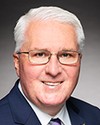Madam Speaker, of course I will follow your ruling. I would say this to my friend. One thing he should be careful of is to not challenge the Speaker. When the Speaker asks him to sit down, he should sit down. He should trust me that this a good piece of advice.
I understand the concern. The hon. member said it was trivializing. I do not think that is fair at all. I could make an argument about how if this was a proportional representation House we might be able to deal with Bill C-18, and a whole lot of other things, more co-operatively, and move them through more quickly. That would be the opposite of trivializing. It would make it a greater priority, and allow it to get through even more quickly. Therefore, there are linkages to all of these things.
I can understand that maybe the member has nothing better to do than to make sure that nobody steps one millimetre outside the boundaries of debate, and that is fine, if that is what the member wants to do with his time. However, I would rather focus on the issues of the day, and the matter in front of us is Bill C-18.
One of the interesting things about Bill C-18 is that there seems to be some debate and concern with respect to the idea of ecological integrity. I am not an expert, but there are those who are suggesting that is a problem. However, when I listened to the experts, who know this issue, they said that this is key.
I want to read a quote from Jim Robb, the General Manager of the Friends of the Rouge Watershed, who stated on December 8, 2016:
Ecological integrity, is it justified? Of course it is. This is one of the most biodiverse areas in all of Canada. Yes, there will be challenges. Yes, this is an aspirational goal, but we can do it...The diversity is so great here and the potential is so high that we should choose no other goal than what has been put forward before you.
During the questions and answers, if there is a focus on that, I would be especially interested to hear from those who have a concern about it. Again, I am not an expert, but from a layperson's point of view it looks like this is a good thing, and one we should be most pleased about.
As I wind up my remarks, it is also worth mentioning that the previous government tried to play a bit of a shell game by announcing it was going to create this park but then did not provide the protections that were necessary, not even to the point where the provincial government would be willing to turn over its lands to the federal government and put it under the umbrella of the national parks system. Therefore, the primary thing this bill does is to bring into force a number of those protections and supports for the park that would then meet the minimum standard of the provincial government in Queen's Park, so that it would feel comfortable knowing that the standards it had in place would at least be met or exceeded. To that degree, we do acknowledge that this is a good bill. We supported it at second reading and took it to committee. We did not get everything we wanted. However, on balance, we are prepared to support this bill. We think it is a good thing.
It is good to point out that the last government played a bit of a shell game. We saw a lot of that, where it would announce things, but if we had a look underneath the shell, there was no pea there, and if we looked under all three shells, there was still no pea there. The former government tried to make it look like it was a tree hugger, when in reality all it was doing was building a cardboard cut-out of a park, like on a Hollywood movie set, rather than implementing the full-blown measures that needed to be taken, which we find in Bill C-18. That is why I am willing to support it.
I certainly hope that no one thinks that this has been trivialized. I still would have liked an opportunity to talk about some of the other issues, but I will look for those opportunities when they are in order so that I am consistent with the rules.
However, at the end of the day, let me say that this bill is completing a job that the previous government started, and we are pleased to be here to support it, and see the proper thing done with this park and with this bill.







